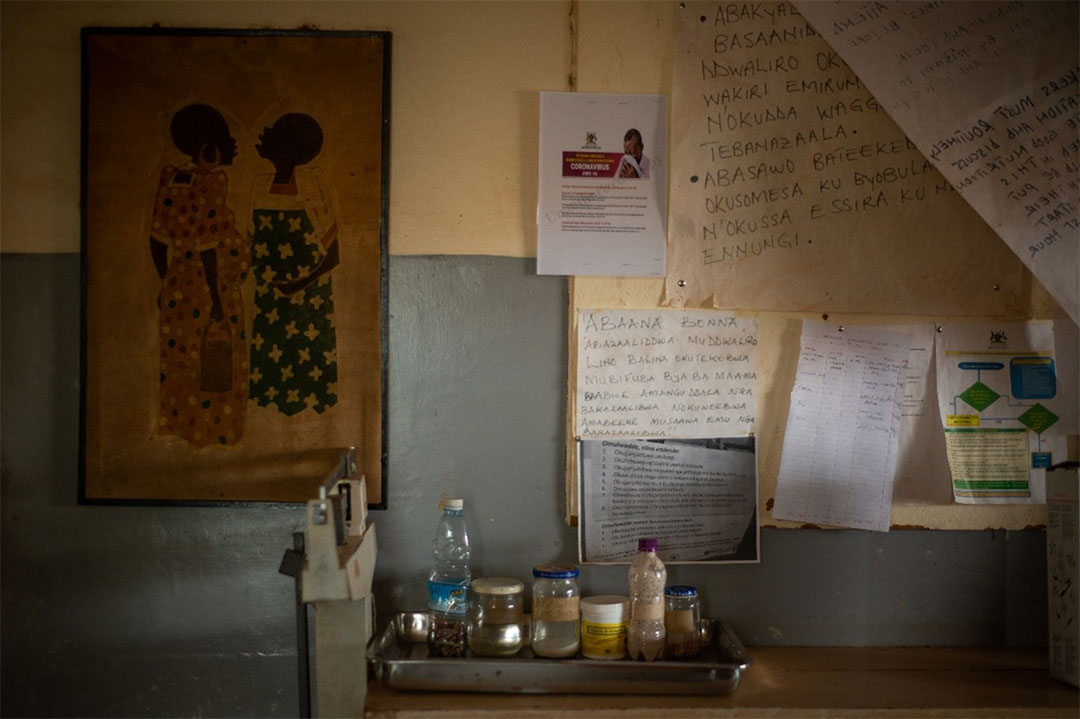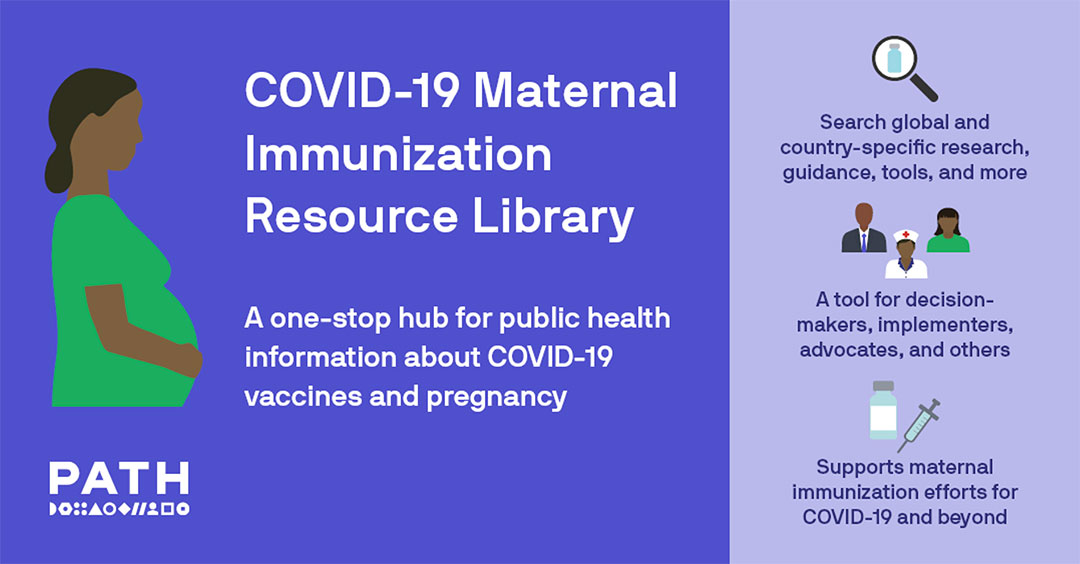Can COVID-19 inspire progress in maternal immunisation?
Vaccination in pregnancy is a powerful public health tool, but underused. New insights from the pandemic may be just the spark needed to energise progress.
- 27 April 2022
- 6 min read
- by PATH

For pregnant people and their babies to have a chance at longer, healthier lives, maternal immunization needs to be part of the equation. Unfortunately, this lifesaving tool isn’t yet used to its full potential as an essential health service, nor against COVID-19 (despite the World Health Organization’s [WHO] interim recommendations that it should be).
“As a result, the world is seeing COVID-19 in pregnancy increase the risk of health complications, including severe illness for the expectant and increased risks of complications in their newborns,” says Sadaf Khan, MBBS, DrPH, MPH, Program Advisor for Maternal, Newborn, and Child Health and Nutrition at PATH. “We’re also seeing longstanding vaccine access inequities and uptake gaps play out in a high-profile way, driven by factors like geography, income, and pregnancy status.”
These issues have significantly raised awareness about the need for maternal immunization, but can a global crisis catalyze new efforts to overcome longstanding vaccination barriers that leave pregnant people and their babies behind? At PATH, we’re optimistic, and we’re partnering to advance tools, research, and connections to make broad use of maternal immunization a reality.
Why maternal immunization?
Maternal immunization can protect against certain diseases that put pregnant people, their infants, or both, at risk. By enhancing an expectant person’s immunity, vaccination can improve her health and/or pregnancy outcomes. Also, her antibodies can pass to baby for defense in early life (breastfeeding can do this, too).
Long before COVID-19, the approach has had a safe and successful track record against infections like tetanus most broadly, and influenza and pertussis in some, mostly higher-income contexts. In fact, vaccination campaigns and supplementary immunization activities have helped the majority of low- and middle-income countries eliminate maternal and newborn tetanus.
Also, development of vaccines for pregnant people has long been underway to combat diseases for which no vaccines yet exist, including respiratory syncytial virus (a top cause of deadly respiratory infection in young infants) and Group B Streptococcus (a leading cause of infant sepsis and meningitis).
Despite its lifesaving power, however, maternal immunization has yet to find a platform for widespread or routine use beyond tetanus prevention, especially in low- and middle-income contexts. With a pandemic upon us and new vaccines on the way, time is of the essence to ensure the groundwork is laid to use maternal immunization as effectively, efficiently, and equitably as possible.
“Pregnant women should have access to WHO Emergency Use Listing-approved [COVID-19] vaccines....”
— World Health Organization
How has COVID-19 raised the stakes?
The global crisis has triggered an uptick of support for maternal immunization. As of March 2022, according to the COVID-19 Maternal Immunization Tracker, more than 100 countries have explicit recommendations that some or all pregnant people should receive a COVID-19 vaccine. Some countries (fewer than 20) have more restrictive policies. Most COVID-19 maternal vaccinations have been delivered campaign style as part of mass vaccination efforts. As such, the pathway to routine maternal immunization is just as much a work in progress for COVID-19 as it is for other diseases.
Have you read?
Efforts are ramping up to bring country, regional, and global stakeholders together to not only better address the pandemic, but to advance optimal platforms for routine maternal immunization more broadly. This includes collaborations like the COVAX Maternal Immunization Working Group, which supports the evaluation and use of COVID-19 vaccines during pregnancy and breastfeeding.
“We have also ramped up our efforts at PATH,” says Jessica Fleming, PhD, project director for PATH’s maternal immunization support project. “In collaboration with WHO, we developed the COVID-19 Maternal Immunization Resource Library as a one-stop hub to connect decision-makers, implementers, advocates, and others with public health information related to COVID-19 vaccines and pregnancy and breastfeeding.”
“We’re also conducting a landscape analysis of pregnancy registries in low- and middle-income countries to better understand maternal vaccination safety monitoring needs. And our health economics experts are leading a series of cost of delivery and health impact analyses spanning several disease targets to support informed maternal immunization decision-making.”

Photo: PATH/Will Boase.
What are the barriers?
One of maternal immunization’s biggest challenges may also be an opportunity to bring health care programs together in new ways. Immunization and antenatal care programs often operate independently of each other within low- and middle-income contexts and serve different populations (children and pregnant people, respectively), yet most routine maternal immunization delivery will need to go through antenatal care as the main health care touchpoint in pregnancy.
“In short, the kind of cross-program coordination needed to bring services together successfully is relatively new territory and must be cultivated inclusively across sectors,” explains Dr. Khan. “Adding value, not burden, to already over-stretched health systems will be key.”
Other barriers include data gaps due to pregnancy and breastfeeding exclusions in vaccine research, safety monitoring limitations, low disease or intervention awareness, misinformation or ineffective communications, poor vaccine suitability/affordability, and competing public health priorities.
These dynamics that have historically dammed the maternal immunization cascade are the same for COVID-19—only amplified. While nearly all countries have received at least some doses of COVID-19 vaccine, distribution has been far from equitable and vaccination rates continue to lag in low-income countries (with only 15% of the population receiving at least one dose of a vaccine). Reaching traditionally un- or underserved populations (such as the pregnant and breastfeeding) in these situations is an even tougher climb.

Graphic: PATH.
An opportunity under the COVID-19 spotlight
The race to vaccinate the world against COVID-19 has showcased why disease prevention is so important at all stages of life, including pregnancy. It’s a highly publicized exposé of systemic vaccine inequities that has given the world a reason to come together in revolutionary ways to address barriers to vaccination—a boon of momentum to also fuel advancement in maternal immunization.
COVID-19 has showcased the need to include pregnant and breastfeeding people in vaccine research and safety monitoring. Although initial COVID-19 vaccine clinical trials may have followed tradition and excluded these populations, more studies involving pregnant and breastfeeding participants have since commenced and are expanding the maternal vaccine safety and performance evidence base.
“What’s exciting is a potential culture and ethics shift in vaccine research to help close data gaps putting these populations at risk,” says Dr. Fleming.
COVID-19 has also triggered new efforts to support the enabling environment for pandemic and routine maternal immunization, including pre-implementation research to aid country decision-making, better information sharing, and dialogue building to advance inclusive cross-sector collaboration.
That means a real chance for lasting progress in maternal immunization. Now it’s time to seize the day.
Editor’s note: PATH’s style guide prioritizes gender neutral language when discussing pregnancy, which can be experienced by all genders. A few instances in this article refer to recommendations or language drawn from other organizations, and from conversational quotation, and therefore do not align with our written style guide. We will continue to promote inclusive language in our sector and in our work—and hope to see inclusive language reflected in all public health applications.
Partner content
This article was originally published by PATH on 26 April 2022 by Lauren Newhouse
More from PATH
Recommended for you









